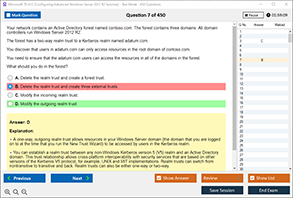Introduction
In today’s interconnected world, securing a network is a top priority for businesses, educational institutions, and even home users. With cyber threats evolving rapidly, implementing robust access control mechanisms is essential to safeguard sensitive data and resources. One of the most effective methods for controlling network access is through filtering techniques, specifically those that leverage IP addresses to specify allowed devices. This blog explores the filtering method that uses IP addresses to manage network access, delving into its mechanics, benefits, and practical applications. For those preparing for certifications or seeking to deepen their networking knowledge, DumpsQueen offers valuable resources to master these concepts.
What is IP Address-Based Filtering?
IP address-based filtering is a network security technique that allows or denies access to a network based on the IP addresses of devices attempting to connect. Every device connected to a network, whether it’s a computer, smartphone, or IoT device, is assigned an IP address—a unique numerical identifier that facilitates communication over the internet or a local network. By configuring a network to permit only specific IP addresses, administrators can control which devices are authorized to access network resources.
This method is commonly implemented in firewalls, routers, and access control lists (ACLs). For example, a company might configure its firewall to allow only devices with IP addresses within a predefined range to access its internal servers. Conversely, it can block IP addresses associated with known malicious actors or unauthorized users. IP address-based filtering is widely used because it provides a straightforward yet powerful way to enforce network security policies.
How IP Address-Based Filtering Works
The mechanics of IP address-based filtering are rooted in the way networks process data packets. When a device attempts to communicate with a network, it sends data packets that include its source IP address. The network’s filtering system—typically a firewall or router—examines these packets and compares the source IP address against a predefined list of allowed or blocked addresses.
There are two primary approaches to IP address-based filtering:
-
Allowlisting: Also known as whitelisting, this approach permits only devices with specific IP addresses or ranges to access the network. All other IP addresses are denied by default. Allowlisting is highly secure because it restricts access to a known set of devices, making it ideal for environments with strict security requirements, such as corporate networks or government systems.
-
Blocklisting: Also referred to as blacklisting, this approach blocks specific IP addresses or ranges while allowing all others. Blocklisting is often used to prevent access from known malicious IP addresses, such as those associated with botnets or hacking attempts.
To implement IP address-based filtering, network administrators configure rules in the network’s security devices. For example, a firewall rule might state: “Allow incoming traffic from IP address 192.168.1.100 to access the server on port 80.” These rules can be highly granular, specifying not only IP addresses but also ports, protocols, and destination addresses.
Benefits of IP Address-Based Filtering
IP address-based filtering offers several advantages that make it a cornerstone of network security strategies. Below are some of the key benefits:
Enhanced Security
By restricting network access to devices with known IP addresses, this method significantly reduces the risk of unauthorized access. For instance, a company can ensure that only employee devices on the corporate network can access sensitive databases, preventing external threats from infiltrating the system.
Simplicity and Scalability
IP address-based filtering is relatively easy to configure, especially in environments with static IP addresses. Network administrators can quickly define rules to allow or block specific devices, and these rules can be scaled to accommodate growing networks. For large organizations, tools like DumpsQueen provide study materials to help IT professionals master the configuration of such filtering mechanisms.
Granular Control
This method allows administrators to create highly specific rules based on IP addresses, ports, and protocols. For example, an administrator might allow a device with a particular IP address to access a web server but block it from accessing an email server. This level of control ensures that network resources are used appropriately.
Cost-Effectiveness
Many firewalls and routers come with built-in support for IP address-based filtering, eliminating the need for additional software or hardware. This makes it a cost-effective solution for organizations of all sizes, from small businesses to large enterprises.
Practical Applications of IP Address-Based Filtering
IP address-based filtering is used in a variety of scenarios, each tailored to specific security needs. Here are some common applications:
Corporate Network Security
In corporate environments, IP address-based filtering is often used to restrict access to internal systems. For example, a company might configure its VPN to allow only devices with IP addresses assigned to its employees. This ensures that remote workers can securely access company resources while preventing unauthorized access from external devices.
Educational Institutions
Universities and schools use IP address-based filtering to control access to their networks. For instance, a university might allow only devices within its campus IP range to access online learning platforms, ensuring that only registered students and faculty can use these resources.
Home Network Protection
For home users, IP address-based filtering can enhance the security of Wi-Fi networks. Many modern routers allow users to create allowlists of devices based on their IP addresses, ensuring that only trusted devices—like family members’ smartphones or laptops—can connect to the network.
Blocking Malicious Traffic
IP address-based filtering is also used to block traffic from known malicious sources. For example, cybersecurity teams often maintain blocklists of IP addresses associated with phishing attacks, malware distribution, or distributed denial-of-service (DDoS) attacks. By integrating these blocklists into firewalls, organizations can proactively defend against threats.
Challenges and Limitations
While IP address-based filtering is highly effective, it is not without its challenges. Understanding these limitations is crucial for implementing a comprehensive network security strategy.
Dynamic IP Addresses
In many networks, devices are assigned dynamic IP addresses through Dynamic Host Configuration Protocol (DHCP). These addresses can change over time, making it difficult to maintain accurate allowlists or blocklists. To address this, administrators may use techniques like IP address reservation or integrate filtering with other authentication methods.
IP Spoofing
Malicious actors can attempt to bypass IP address-based filtering by spoofing their IP addresses—masquerading as a trusted device. While firewalls with advanced packet inspection can mitigate this risk, it remains a potential vulnerability in simpler systems.
Management Overhead
In large networks with numerous devices, managing IP address-based filtering rules can become complex. Administrators must regularly update allowlists and blocklists to account for new devices, departed employees, or emerging threats. Tools like those offered by DumpsQueen can help IT professionals stay updated on best practices for managing these rules efficiently.
Limited Scope
IP address-based filtering focuses solely on IP addresses and does not account for user credentials or application-level security. For comprehensive protection, it should be combined with other security measures, such as multi-factor authentication (MFA) and intrusion detection systems (IDS).
Best Practices for Implementing IP Address-Based Filtering
To maximize the effectiveness of IP address-based filtering, network administrators should follow these best practices:
-
Use Static IP Addresses When Possible: For critical devices, assign static IP addresses to simplify the creation and maintenance of filtering rules.
-
Regularly Update Filtering Rules: Periodically review and update allowlists and blocklists to reflect changes in the network, such as new devices or emerging threats.
-
Combine with Other Security Measures: Integrate IP address-based filtering with other security technologies, such as VPNs, MFA, and endpoint protection, to create a layered defense.
-
Monitor Network Traffic: Use network monitoring tools to detect anomalies that might indicate IP spoofing or unauthorized access attempts.
-
Leverage Professional Resources: Platforms like DumpsQueen provide comprehensive study guides and practice exams for certifications like CompTIA Security+, Cisco CCNA, and CISSP, which cover IP address-based filtering and other network security topics in depth.
Conclusion
IP address-based filtering is a powerful and widely used method for securing networks by controlling access based on device IP addresses. Its simplicity, scalability, and granular control make it an essential tool for organizations and individuals alike. However, to fully leverage its benefits, administrators must address challenges like dynamic IP addresses and IP spoofing while integrating it with other security measures. By following best practices and staying informed through resources like DumpsQueen, IT professionals can master IP address-based filtering and build robust network security frameworks. Whether you’re preparing for a certification or seeking to enhance your network’s defenses, understanding this filtering method is a critical step toward achieving your goals.
Free Sample Questions
-
What is the primary function of IP address-based filtering?
a) To encrypt network traffic
b) To control access based on device IP addresses
c) To monitor application performance
d) To assign dynamic IP addresses
Answer: b) To control access based on device IP addresses -
Which of the following is a benefit of IP address-based filtering?
a) It eliminates the need for firewalls
b) It provides granular control over network access
c) It automatically detects malware
d) It simplifies user authentication
Answer: b) It provides granular control over network access -
What is a potential limitation of IP address-based filtering?
a) It is incompatible with modern routers
b) It cannot block malicious traffic
c) It may be bypassed through IP spoofing
d) It requires expensive hardware
Answer: c) It may be bypassed through IP spoofing -
Which practice enhances the effectiveness of IP address-based filtering?
a) Disabling network monitoring
b) Using dynamic IP addresses for all devices
c) Regularly updating filtering rules
d) Relying solely on blocklisting
Answer: c) Regularly updating filtering rules



